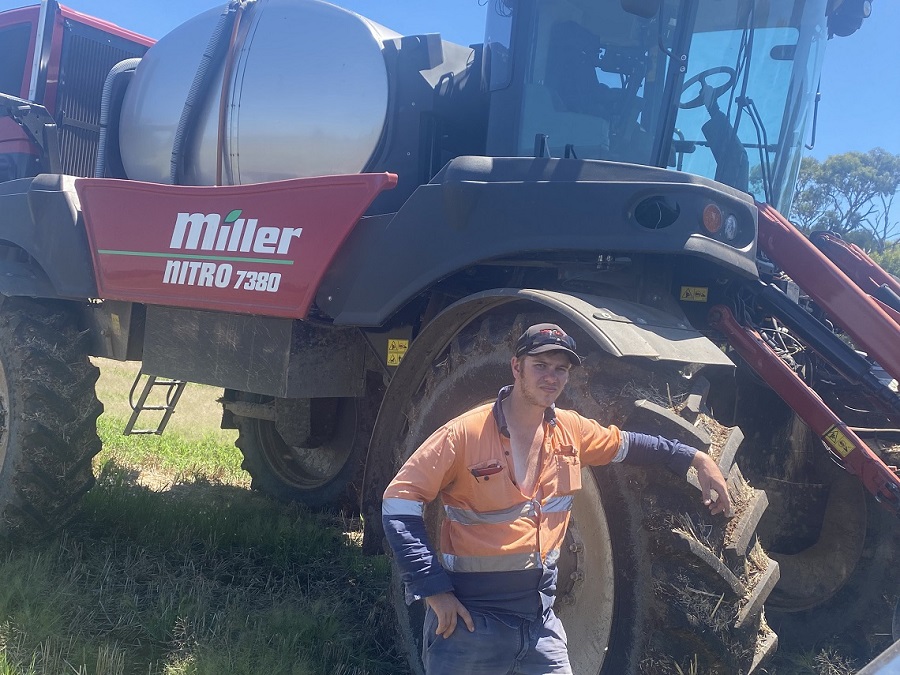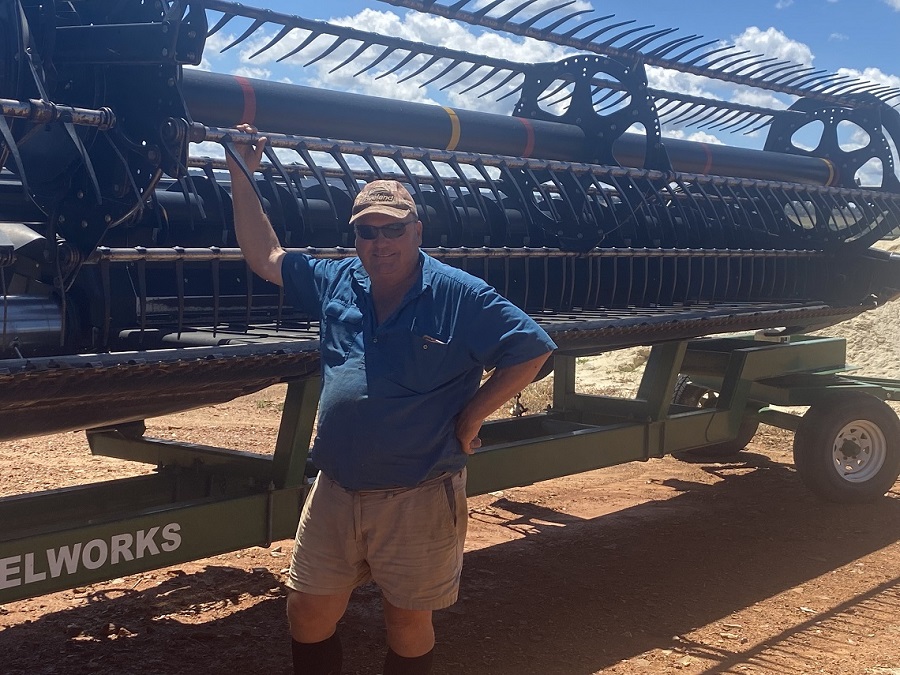30 March 2023

Photo caption:Austin Pocklington, spray operator for the Ziebarth family over their properties through Southern New South Wales, takes a break from the office, one of the latest 7380 models from the Miller Nitro 7000 Series.

Photo caption:Selecting a sprayer also for windrowing put Southern New South Wales grower John Ziebarth into Miller sprayers many years ago. He is pictured with a 12-metre (40-foot) MacDon front, which is easily attached with a special bracket adaption frame that Miller offers as an option for both MacDon and Honey Bee fronts of this size.
THE ability to windrow as well as spray has been a long-term sprayer rig prerequisite for Southern New South Wales producer John Ziebarth, and while latest upgrades also have delivered added versatility, efficiency, comfort and systems technology, windrowing remains a key driver.
John and his family farm over five locations from Moorwatha, near Albury, stretching north-west up to Coreen Hill, near Daysdale.
The properties sit in a rainfall belt ranging from 450 millimetres annually in the north to 600mm in the south and they are predominantly cropped to wheat and canola, as well as pulse crops where required to suit rotational management. The family also runs about 100 Black Baldy heifers.
Their sprayer can pass over paddocks six times in a 12-month period, and John said it was put to work more last season to help combat a range of diseases including sclerotinia in canola, as well as leaf and stripe rust in their wheat.
“When you add the summer spraying and in-season herbicide applications, including for resistant ryegrass in places and fleabane, which is a constant problem, as well as the windrowing of canola, it gets used a hell of a lot,’’ John said.
The vital windrowing element put John in the seat of a Miller Nitro 4000 Series sprayer with a swather kit many years ago and his preference for the manufacturer’s sprayers has not waned, later upgrading to a 6000 Series and last season to a new 7380 model.
He uses a 12-metre (40-foot) MacDon front for the swathing, easily attached with a special bracket adaption frame that Miller offers as an option for both MacDon and Honey Bee fronts of this size. Other bracket kits also are available to suit MacDon D Series and Honey Bee combine and swather fronts.
Fortunately, John’s local Miller dealer, Wiesners at Walla Walla, is just 2 kilometres away from their southern properties and they had one ready to go for last season with a good deal. John said the dealer’s support for the machine from start-up and throughout the season was excellent.
The latest Miller Nitro sprayers incorporate a motor change to an IVECO Tier 2 turbo diesel engine, delivering 383 peak horsepower with 1459NM of torque for the 7380 model. This increases to 434 peak horsepower with 1629NM of torque for the larger 7420 sprayer.
An innovative hydrostatic Danfoss pump system featuring electronically-controlled variable displacement, bent axis drive motors and integrated Fairfield Torque-Hub planetary final drives provides an improved drive performance with the new Miller sprayers. The drive motors supply greater torque at all speeds, while the weight distribution has been carefully designed to ensure it remains within 4 per cent of 50:50 balance during spraying. This package of power, control and balance leads to a strong overall experience.
John said the traction control with their Miller Nitro 7380 was fantastic in the wet conditions last season and effectively saved the need to contract aircraft sprayers.
“This machine marches through bog holes, whereas the older sprayers could get bogged.’’
“When you are coming to a wet spot, all four wheels can lock-up like a diff-lock, and it’s got a built-in limited slip.’’
He said their tramline tracks can often get compacted and full of water, but the Miller Nitro 7380 encountered no problems.
It was fitted with narrower (480/80R50 VF-style) tyres as well, which hence were knocking down less crop, however they are taller.
“They are just as much rubber as the other tyres and allow a longer footprint – we were very impressed,’’ John said.
Stability was another feature in their hilly country and they were pleased with the fuel efficiency improvements compared with previous sprayers.
“We can spray a bloody lot on a tank full of fuel now,’’ John said.
High machine clearance is appreciated particularly with late fungicide applications in canola, and he said the Raven XRT high resolution height control system and one-touch auto-fold feature were further great features. The Raven XRT is a radar-based ultrasonic system that collects data points, ensuring booms remain at optimum spraying height for longer.
The Ziebarth’s Miller Nitro 7380 uses the manufacturer’s IntelliSpray pulse nozzle system, which provides individual nozzle control and maintains droplet size as the speed of the sprayer changes.
John said the individual nozzle control and turn compensation, effectively increasing the spraying speed on the outside of their 36m (120ft) boom whilst slowing down the inside as the machine turns, were other significant advancements.
The Raven controller also works seamlessly with their John Deere SolSteer guidance system.
“All we did is just plug it in and operate,’’ John said.
The Ziebarths and their workers also have given a big tick to the new cabin environment with the latest Miller Nitro 7380 sprayer.
“It’s a bit quieter and it’s way more comfortable,’’ John said.